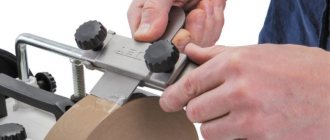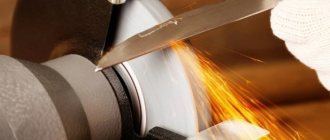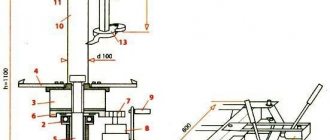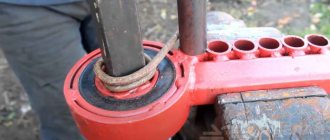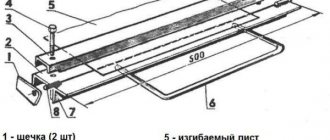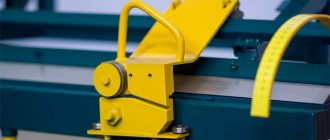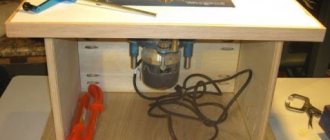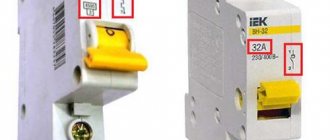I’ll tell you how a thicknesser differs from a jointer - it will be clear even if you don’t know these words
We will send the material by email
Many novice carpenters cannot figure out the difference between a surface planer and a jointer. Looking at the result, it may seem that both machines do the same thing, therefore, it is enough to buy either one. This is not true. There is a huge difference between thicknesser and jointer machines, although they look the same in design. You can get perfectly even boards of the same thickness only by using both devices.
Design
The design of the machine in question includes the following parts:
- The engine runs on 220 Volts. An electric motor creates and transmits “torque” to the planing shaft with knives.
- A work table consisting of front and rear plates (made of cast iron and having special stiffening ribs, which ensure the stability of the working surface). The edges of the tiles are provided with special stainless steel overlays that protect the working surface from mechanical damage. The back plate is installed at the same level as the cutting blades. The front plate is located 2 mm lower than the rear one. The distance between them varies, which depends on what layer of material needs to be removed from the workpiece being processed.
- Bed, which is made of very durable alloys. This element supports the entire mass of the machine, and must also withstand the forces that the operator applies to pressing the workpiece. It also contains shafts with knives, guide parts and other fasteners.
- Planer shaft installed between front and back tiles. Blades of equal thickness, made of high-speed tool steel, are attached to this shaft. In the case when it is necessary to process hard wood material on a machine, the shaft must be additionally equipped with carbide tips.
- Guide - this element is a unit that is responsible for moving the moving parts of the equipment and the workpiece itself. The guide is attached to the frame by bolted connections and can move in a transverse direction.
- The circular fence is placed on the front tile and should fit snugly against the guide. This guard is made of sheet metal and provides protection for the knife shaft.
Operating principle
The complete operating procedure of the equipment consists of the following steps:
- The back tile remains stationary throughout the entire production process. The location of the front tile is adjusted by the operator to the required height.
- After turning on the machine, the electric motor transmits speed to the knife shaft, as a result of which the cutting parts begin to rotate.
- The wooden blank is applied to the guide element (ruler) with both hands and directed to the cutters (knives). If the machine belongs to budget models, then feeding on it is carried out only manually, and this is dangerous. However, most modern machines are already equipped with an automatic feeder, which increases the speed of delivery of parts and ensures the overall safety of the production process.
- When the workpiece falls under the knives, they remove a layer thickness determined by the operator from the wood, thereby eliminating unevenness and creating a clean and flat base surface. The execution speed will directly depend on the planing technology. Most jointer machines can only finish one surface at a time, but there are already jointers available that can handle two sides at the same time.
If, upon completion of processing, small irregularities or fibers form on the surface, this indicates that the knife blades need to be sharpened again. If the unevenness is large, the distance between the tiles and the planing shaft must be properly adjusted.
What is a thickness planer
First of all, it’s worth understanding what a jointer and surface planer are.
A thickness planer is a machine designed for processing wood. It is a type of planing machine and is used to produce boards of a certain thickness. The machines are used in home workshops and in industry. With their help, wooden blanks of a strictly specified thickness are obtained, as well as an even and smooth surface.
It is worth noting that a thicknesser is also called a measuring device, thanks to which boards are measured before cutting.
The work process is simple: the board is fed manually or using rollers along the work table. It passes under the knife shaft, which removes part of the wood and at the same time presses it. If the thicknesser is double-sided, then there are two knife shafts on it - on the top and bottom, on the table. This allows the material to be processed faster.
There are also multi-sided thicknessing machines. They process three or more sides of the workpiece simultaneously. Such devices are characterized by increased productivity, high price and significant size. They require careful care and regular repairs.
Before choosing a thicknesser or jointer, it is worth learning more about them. Thicknessers are divided into:
Mobile machines are usually purchased for a home workshop. They are small, inexpensive, but do the job well.
Sharpening jointer knives
Despite the fact that the knives of electric jointers are made of high-strength high-speed steels such as R6M5, R12F4K5, etc., they become dull with intensive use. Chinese models use knives made of tool steel type 9ХС, which fail even more often. There are models that are equipped with carbide knives, which split when they hit a metal object (the need for a preliminary inspection of the workpiece has already been mentioned earlier). Thus, the home craftsman is faced with the problem of high-quality tool sharpening.
The sharpening process depends on the shape of the jointer knife. It can be smooth or spiral-shaped. Spiral-shaped knives, although more expensive, allow you to obtain an absolutely flat surface without the need to separately adjust each blade. In many models, the increased durability of knives is due to their design: there are devices for gradually stopping the knife shaft and protecting the knives from foreign objects entering their area of action.
Sharpening knives for jointers at home is done as follows. You will need a hand sharpener with a non-greased stone and water cooling (such devices are produced by the Tormek brand). The knife is secured in the holder, and the required sharpening angle is set using the adjusting screw. It is important to accurately rest the back of the knife against the stop, otherwise sharpening will be performed with the blade skewed. By moving the holder left and right, sharpening is carried out, the quality of which is controlled using sliders located on the stop.
What is a jointer
A jointer is a carpentry tool that is used to level the surface of a wooden piece. As the name suggests, a jointer is used for jointing or creating a base. The result is perfectly flat edges, without grooves, depressions or screws.
The design of a jointer differs from that of a planer. The knife shaft is mounted on the machine bed. The back of the table should be level with the cutting shaft. The table itself consists of a fixed back part and a liftable front part, which is adjusted according to the thickness of the material that is planned to be removed at a time. The workpiece is pulled along the front table through a knife shaft, which removes the layer. You need to carry the board several times to get a completely smooth surface.
When analyzing the difference between a thicknesser and a jointer, it is worth noting the functions of the second. The jointer is used:
There are several types of machines. They are single-sided and double-sided (you can process two planes at a time), manual and electric, and also differ in power, size, speed, etc.
How to use a hand-held electric jointer?
It should be noted that using a handheld electric jointer successfully will require practical skills. The preparatory operations are:
- Adjusting the jointer to the required depth and width. In household models, it is possible to process planes with a width of 50...110 mm. There is a relationship between the power of the unit and the permissible planing width. For example, electric jointers with a power of 450...600 W work well on material up to 80...85 mm wide, 600...1000 W - up to 100...110 mm. The planing depth is set according to the stop, and depends on the parameters of the wood. The blades should protrude from the shaft by no more than 2 mm, and during the first experiments with the unit, it is worth setting the depth to no more than 1...1.5 mm, gradually increasing it to the recommended one (usually no higher than 2.5 mm in one pass) ;
- Checking the engine speed. Manual electric jointers are equipped with a drive from 10,000 min-1. There is an opinion that with an increase in the speed of the electric motor, the functionality of the unit increases. This is wrong. The higher the speed, the lower the torque and force, which can have a negative impact on the processing of particularly strong wood. Another recommendation would be more correct. As the speed increases, the working depth decreases, but the speed of movement of the electric jointer across the workpiece increases;
- Determination of feed rate. As the engine speed increases, the surface finish of homogeneous and relatively soft wood increases. Therefore, practical feed can be up to 25...30 mm per second with a knife penetration depth of up to 1.5 mm, and 10...20 mm - over 1.5 mm.
Before starting work, you should securely and conveniently secure the workpiece on the workbench. It is recommended to start work from the end part of the board, and at a minimum penetration depth. After making sure that the first pass has a positive result (no wood tearing, no jerking of the unit when moving it, etc.), the feed and depth can be increased. Before this, the unit is disconnected from the power supply and the knife drum is waited until it stops completely. A preliminary inspection of the board is also required to exclude the presence of nails and other metal objects in it.
For straightness of movement, it is worth marking the board with a solid line (for example, with colored chalk). In addition to an additional guarantee of straightness of movement of the sole, this determines the uniformity of processing: where the markings were preserved, the depth of penetration of the knives turned out to be less than required.
What's the difference
Although both machines remove the top layer of wood and process boards, there are many differences between them. Moreover, in design, both devices have many common features, which is why it seems that they are interchangeable.
The main difference is in the purpose. If a jointer allows you to simply get a flat surface (remove all bulges, holes and other evenness), then a thicknesser gives the board the same thickness (the board will have the same thickness along its entire length). After this, it can be used in construction or renovation.
When analyzing the differences between a jointer and a planer, it is important to note one feature. A thickness planer levels the surface parallel to the opposite one. That is, if the opposite surface is uneven, the side processed with a thicknesser will not be smooth. But the thickness of the board will be the same anywhere.
To get the perfect board, it is first “smoothed” on a jointer, then passed through a surface planer. In other words, the jointer performs the primary processing, and the thicknesser does the finishing.
It is not recommended to use only one machine, since it will not be possible to obtain a completely satisfactory result. If the board was curved, then after the surface planer it will remain that way, only the thickness will be the same. If the board had different thicknesses at the ends, after processing on the jointer this will remain, but the sides will be smooth and perfectly even.
These are all the differences between a surface planer and a jointer. The complete work cycle looks like this:
There is also a planer-thicknesser machine. It combines both devices, which saves space and allows for high-quality processing. However, such machines are usually quite expensive and are used in industry.
The difference between thicknesser, jointer and combined machines is clearly shown in this video
Comparative characteristics
- Since a jointer is a type of planer, there are not many differences between them. Both products are used to remove “excess” material from workpieces in order to obtain a perfectly flat surface. The main difference is the degree of processing of the product
. - The plane is used as a tool for primary processing
. The thickness of the removed wood layer is usually set when setting up the equipment. Wood planing is primarily intended to eliminate knots, bumps and other irregularities. The design itself is always simple: 2 elements - a block and a knife. - The jointer, as a rule, has a longer body
, which ensures that the product is pressed very tightly against the wood being processed. Most often, the jointer is equipped with two blades, allowing for finishing.
Briefly about the main thing
Many novice carpenters do not immediately understand why a surface thicknesser and a jointer are needed. They think that machines do the same job, that they can get by with only one tool. In fact, the difference is significant, but it can only be seen if you understand the operating principle of each machine.
The jointer is intended for rough processing of boards. It cuts off the top layer, making the board absolutely smooth and even, removing bulges and “bumps”. Thicknesser is responsible for thickness. With it, the board has the same thickness in each place.
To get perfect boards, you need to use both machines or process them with a planer-thicknesser machine, which combines both options.
Write in the comments, do you process the boards or buy them already completely finished? What devices do you use?
Source
How to joint boards correctly?
The wood cutting machine used is characterized by its specific properties. Jointing is a process of processing the surface of wood of varying densities. The recommendations are as follows:
- Take the handle with your left hand, and the block with your right.
- The tool is guided along the fibers.
- As the product is ready, the chips become long and even throughout their thickness.
When working, do not handle the blade; you should wear protective clothing while working. At the time of work, the boards must be securely fastened.
Planer, jointer or planer
All three tools level the surface of the wood, and their difference lies in the different quality of the resulting surface and the principle of cleaning technology:
In the operation of professional machine equipment , a distinction is made between the work of a thicknesser and a jointer:
Proper Use of a Portable Electric Planer
Jointing refers to the processing of wooden elements using any type of jointer.
The portable tool can be fixed permanently for ease of processing. Procedure: To control the thickness of the cut layer, draw a line with chalk on the workpiece.
The layer above it should disappear smoothly, and the line itself should be removed if an even workpiece is obtained. To work with the edge, the board is turned to the blade with the corresponding side, then all actions are repeated in the same sequence. Working with a jointer mounted on a work table is not difficult, but requires compliance with safety precautions:
To
protect the worker from premature switching on of the tool, it is equipped with a protective tool control system. There are two power buttons on the case; power is supplied only when they are pressed simultaneously.
External structure of the hull
There is a socket on it for connecting the vacuum cleaner pipe and making it easier to remove chips; most often, models are equipped with such an entrance on the right. A handle for support during operation and control buttons are installed on the body. There is a manual screw to adjust the planing depth and layer thickness. To change the width of the processed strip, a stop is provided on the side .
The tool has a protective casing that can be folded down when needed. The lower sole of the unit is made of thick aluminum sheet. On the case there is a connector for connecting a battery or batteries with a voltage of 18 V. The kit includes a working cable 2 meters long with a plug for a household network.
Working area dimensions
An important criterion for choosing an industrial machine is the width of the table. Depending on the size of the parts that are intended to be processed, modifications of planing units can be divided into the following types:
- Heavy, with a milling width of up to 63 cm.
- Medium, for which this figure is 40 cm.
- Lightweight, with a table width of 25 cm.
The table has a smooth surface. Its receiving part is located at the level of the contour formed during torsion of the knives. The front plate is adjustable; by adjusting it, it is set below the receiving half of the work table to the thickness of the layer that needs to be removed in one pass of the board.
Stationary electric jointer
Such stationary units are much more expensive than portable options, but their functionality is much wider. Operations that can be performed on a stationary jointer:
On jointing machines, the blade shaft speed is up to 6 thousand per minute, high productivity is obtained due to the high power of the equipment (6 kW). Other characteristics and parameters of the jointer look like this:
Principle of operation
The knife shaft of a stationary machine is located perpendicular to the axis of the bed in radial rolling bearings, which leads to compensation of all possible shifts of the part during operation and uniform distribution of the working forces of the two blades .
The work table consists of two parts, where the back part is made stationary and stands on the shaft axis, and the front part rises or falls to the height of the layer being planed. The part is fed manually or automatically, and in the memory of such a machine with software there are several options for processing different categories of wood. Some models provide planing of two surfaces at the same time.
To make adjustments in operating mode, lower the table, place the required number of knives on the shaft and adjust their parallel arrangement using the indicator. After this, all parts are secured and the feed mechanism is turned on. Before operation, the machine is checked at idle speed .
The design of a jointer, stationary or manual, is fundamentally the same. An electric motor rotates a knife drum with several removable blades through a reduction gearbox. As the tool head rotates, a vertical feed is imparted. Included with the equipment are several types of blades for planing hard and soft wood, their number ranges from 1 to 3.
Features of operation and device
The equipment in question is characterized by certain application features. Among the features we note the following:
- The bottom surface must be level. This can be achieved by pre-jointing.
- Simultaneous processing is only possible when using a machine that has the appropriate properties.
- The machine is ideal for working with previously unprepared workpieces.
- The device is designed as a combination of several parts, all of which are responsible for specific functions.
In general, we can say that such a machine is characterized by high functionality. The design of a jointer of this type may differ significantly.
Planer-thicknesser machine
It is a combined unit that organically combines the functions of a thickness planer and a jointer.
Its advantage lies in this functional combination. After the initial cutting and pre-processing of the boards, they are sent for surface thicknessing and jointing. The task of the paired equipment is to eliminate all irregularities. The machine consists of a work table attached to a frame. The workpiece is fed to the bed, and the work table is intended for receiving; between them there is a knife shaft with blades.
A planer and at the same time a thicknessing machine performs two operations simultaneously, so its use is justified in large-scale industrial production. It can be used in the construction of high-rise buildings. High-quality processing is guaranteed, and incoming primary lumber can be corrected on site without any problems.
Features of operation and device
If you only use a jointer or surface planer, you will not be able to achieve a properly processed surface:
Recommendations when choosing equipment
The woodworking market offers a large assortment of FRS. When choosing a worthy unit, pay attention to the following parameters and characteristics:
Types of machines
The machines are a single system of planing and thicknessing. The powerful asynchronous motor is protected by a belt drive from increased overloads and operates with reduced noise emissions.
If during operation there is a failure in the electrical power supply, then spontaneous restart is impossible due to the use of a magnetic starter in the design. To reduce friction, the surface of the bed and work table is made of polished cast iron. For ease of operation, the receiving table and the serving table are made quite long. Switching from planing to thicknesser and back occurs quickly; for each mode, the nozzle has two positions. The machine operates without vibration.
Machines with simultaneous planing and thicknessing have undeniable advantages and improvements:
Popular models
KRATON 01 ptwm is equipped with a rigid frame, automatic feeding of parts is provided, a magnetic starter serves as protection against arbitrary switching on, a built-in turbine collects waste chips and dust, engine power is 1.6 kW, the maximum grip size is 2.5 mm, the speed is 8 thousand. in a minute.
STARK 1700 PWJ was developed by German designers, the model is distinguished by high quality characteristics. There are 2 knives on the shaft, the width of the planing strip is 203 mm, the speed of the part is 6 m per minute, the engine power is 1.7 kW, the shaft speed is 9 thousand revolutions per minute.
Source
Models
When choosing equipment, you need to take into account the size of the workpiece and the volume of work performed. If you plan to process small bars, you can purchase a compact model with a power of 4 kW. For large lumber, you will need a larger unit with a high-performance engine.
Joining machines "Kraton"
Model Kraton WMPT-260 (39,300 rubles) performs jointing and thicknessing, has a power of 1500 W, is compact, and is equipped with automatic feeding of workpieces.
Jointer JET
Combined machines JET JPT-10B (34,000 rubles) with a power of 1.5 kW are distinguished by their small dimensions and the ability to extend the working surface.
JET JPT-310 machines (80,000 rubles) have a power of 5 kW and are distinguished by double motor insulation. It is possible to connect a vacuum cleaner.
The JET Jointer 6'' jointing machine (193,000 rubles) with a capacity of 3.5 kW is equipped with a shaft with 48 knives. This is equipment for jointing and thicknessing.
SF-4 machines
The single-sided jointing unit SF-4 (179,000 rubles) has a two-knife round shaft that makes 5000 rpm. The machine is equipped with a three-phase squirrel-cage asynchronous electric motor.
Holzstar ADH 305 machine
A tabletop planer-thicknesser unit with a power of 1.8 kW is equipped with two knives and a rubber-coated output shaft. The average price is 44,900 rubles.
Brand Corvette
Series 106 (29,960 rubles) with a power of 1.5 kW is equipped with special pushers and a shaft with three knives.
The Enkor Corvette-24 sample (18,130 rubles) has a power of 1.25 kW and allows you to quickly switch planing from thicknessing to jointing mode.
Machines MB5026
The single-sided model MB5026 (54,900 rubles) made in China is equipped with a shaft with three cutters and has a power of 3 kW.
Brand Scheppach
Planer-thicknesser machines Scheppach HT-1050 (23,000 rubles) with a power of 1.5 kW and a productivity of 9000 rpm demonstrate reliable operation and clean processing of lumber.
The Scheppach HT-850 sample (17,000 rubles) of combined action with a 1.25 kW motor is compact and allows for a smooth surface of the workpiece.
The HT-650 jointer (18,020 rubles) is equipped with a 1.28 kW engine, has a mobile design, and provides for manual feeding of lumber.
| Manufacturer | Model | Power, W | Average price, rub |
| Kraton | WMPT-260 | 1500 | 39 300 |
| JET | JPT-10B | 1500 | 34 000 |
| JPT-310 | 5000 | 80 000 | |
| Jointer 6'' | 3500 | 193 000 | |
| Kurgan plant of woodworking machines | SF-4 | 2800 | 179 000 |
| Holzstar | ADH 305 | 1800 | 44 900 |
| Corvette | 106 | 1500 | 29 960 |
| Enkor Corvette-24 | 1250 | 18 130 | |
| — | MB5026 | 3000 | 54 900 |
| Scheppach | HT-1050 | 1500 | 23 000 |
| HT-850 | 1250 | 17 000 | |
| HT-650 | 1280 | 18 020 | |
| Makita | 2012NB | 1650 | 41 000 |
| DeWalt | D27300 | 1600 | 78 900 |
The price of Makita and DeWalt machines depends on the type of device and its configuration. The Makita 2012NB planer-thicknesser has a power of 1.65 kW, the price is about 41,000 rubles. The DeWalt D27300 machine with a power of 1600 W costs 78,900 rubles.
Video review of the Enkor Corvette-24 jointer.
We make a jointer with our own hands in manual and electromechanical versions
Various tools are always needed to perform various carpentry and carpentry jobs. Every craftsman, and even those who like to “tinker” with wood, should have various chisels, knives, saws, planes and other devices on hand.
At the same time, very often true professionals prefer a tool made by hand or to order. In this case, the work will definitely be done efficiently and with minimal effort.
How, for example, can you make a jointer with your own hands? What is needed for this and what are the stages of completing such a task?
Connecting mechanisms
Rotation is transmitted from the engine to the shaft by means of a belt drive through pulleys. The pulley sizes are selected in accordance with the engine power and speed.
For a drive with a rotation of 3000 rpm, a ratio of 1 to 2 can be considered normal. For example, the diameter of the cutting tool pulley is 100 mm, on the drive it is 200 mm. The optimal ratio for DIY assembly can be obtained experimentally and largely depends on the quality and balancing of the rotating parts of the jointer.
The drive is connected to the electrical network using a starting device, in accordance with the instructions of the electric motor.
What is a jointer and why do you need it?
Initially, you should understand for what purposes you need to use a jointer. The general concepts for creating it yourself will depend on this. This tool is simply necessary when finishing large wooden pieces.
The main difference between a hand jointer and a planer is its larger size.
The design of the jointer is very similar to the design of a universal plane. The main difference, along with the larger size, is the installation of a double knife. It is fixed using a special plug, which is located in the front part of the structure. For ease of operation, the plane is equipped with a handle located behind the knife.
For leveling, a jointer is passed over the surface of a wooden workpiece. In this case, at the beginning of the work, the chips will turn out torn. But there's nothing wrong with that. Gradually the chips will become smooth and continuous. This is what will mean that the workpiece has reached the desired levelness.
Very often, for further work, specialists change the jointer to a semi-jointer. Its device is no different from its older brother. The main difference is the smaller size. This allows you to process the surface better.
But modern craftsmen rarely use a simple jointer. It is more convenient to use an electric version mounted in the form of a machine. This device allows you to significantly speed up the processing of wooden parts. At the same time, quality is not lost, but rather improved.
The difference between a jointer and a simple jointer or planer is the way it is used. In this case, the installation itself remains in place, and the master moves the workpiece. When passing along a moving shaft with knives, a layer of 1-2 millimeters is removed from the wooden part. As a result, the workpiece is obtained with a perfectly flat surface.
Types of tools
The classification is very extensive and is associated with various properties. There are two main types:
- A hand jointer can be found in almost any workshop. Its peculiarity lies in the prostate of the device, as well as its low cost.
- Recently, an electric jointer has often been purchased. This is due to ease of operation, as well as fairly high efficiency in use. The only drawback is the fairly high cost.
The materials used in the manufacture of the main part may differ significantly. Wooden tools are more common, as they are simple and much cheaper. It is suitable for a home workshop. There are also metal structures designed to work in extremely difficult conditions.
The classification is carried out according to what the task is. Examples include the following devices:
- For working with wooden workpieces that have not been processed in any way before. This variety is called Sherhebel. In most cases, a metal is used that can withstand significant impact.
- If finished parts need to be glued together after processing, then tsinubel is used. This design option is characterized by the fact that the knife has serrations. After planing, small grooves appear on the surface. As practice shows, such a surface is best suited for gluing.
If the resulting products do not need to be glued together in the future, you can use a double or single jointer. The main types of carpentry tools include the following:
- The grinder is represented by a type of design, which is characterized by a shortened body and an increased rake angle, as well as a reduced slot for removing chips. The scope of application is to align the ends and remove various burrs.
- In some cases, a semi-joint is used. It is characterized by a reduced length, but the required width remains. Used when working with large parts.
- The folding belt is used for sampling and quartering. It has a design that has a removable sole. The tool differs from others in width and is a specific design option.
- Zenzubel has a double-sided knife made using high-quality steel. The width of this element is 33 mm.
Mini jointers are also available for sale. It is often used in domestic settings, as it is small in size and has sufficient performance. In addition, all devices can be divided into two main groups:
- Household is characterized by low cost, as well as reduced performance characteristics. It is widespread because it costs less.
- A professional jointer is used for work in industry. Its main qualities include increased productivity, as well as the ability to work for a long period.
The production of the instrument in question is carried out by a variety of companies. There is also an industrial jointer that can be used for a long period.
Manual jointer
Most work can be done using a hand jointer. This can be associated with the following points:
- The device is easy to use.
- It is possible to process various surfaces.
- The tool is inexpensive.
The desktop version can have a very different device; the choice is made by a specialist depending on what work needs to be done.
Electric
Today, a stationary jointer can be manufactured in an electric version. Professional devices are characterized by the following features:
- Quite a large mass and clamping force.
- During operation, high precision can be achieved.
- Increased labor productivity.
- Often the design provides the ability to quickly change knives.
The electric jointer is used in industry and everyday life; the product is characterized by high performance characteristics. The only drawback in most cases is the high cost, as well as significant energy consumption.
Making a manual version of the jointer
If you like to do everything with your own hands, including processing wooden workpieces with a hand jointer, then you can easily make this tool yourself. First prepare a wooden block. Its dimensions must match the future jointer. The block should be taken from hard wood, for example, larch or oak. The stronger the workpiece, the longer your plane will last.
During production, you should take into account some recommendations on the size of the future tool. Experts recommend using the following parameters:
Next, a thin wooden plate is installed (which will act as a wedge). Next, the shock plug should be installed. To do this, select a place in the middle between the edge of the hole and the front edge of the jointer itself. At this point, the main working part is ready for use.
But it will be difficult to work with such a tool. For convenience, it is necessary to attach a handle. Its shape should ideally fit your hand, so it is made individually. To make a handle, you can use multilayer plywood.
For even greater ease of use of your new jointer, you can optionally install a second handle. Also, some models are equipped with two blades. But this will depend on your personal preferences. The most important thing is that before work, the knife blade does not protrude beyond the underside of the tool by more than one millimeter.
Review of factory models
| Model | W0108 | W0106FL | W0103FL | W0100 |
| Engine | 0.75 kW 220V | 0.75 kW 220 V | 2.2 kW, 220V | 3.7 kW 380V |
| Cutting width | 153 mm | 153 mm | 203 mm | 400 mm |
| Maximum cutting depth | 3 mm | 3.2 mm | 3.2 mm | 3 mm |
| Number of knives of the cutting shaft | 3 | 3 | 4 | 4 |
| Cutting shaft diameter | 61 mm | 61 mm | 78 mm | 98 mm |
| Table length | 1210 mm | 1535 mm | 1800 mm | 2250 mm |
| Feed table length | 700 mm | 760 mm | 880 mm | 1090 mm |
| Reception table length | 590 mm | 755 mm | 880 mm | 1090 mm |
| Table width | 255 mm | 255 mm | 330 mm | 420 mm |
| Table height from floor | 820 mm | 850 mm | 795 mm | 820 mm |
| Stop dimensions | 740 x 98 mm | 889 x 124 mm | 889 x 124 mm | 1195 x 150 mm |
| Packaged sizes | 1245x515x275 mm | 1600x360x250 mm | 1850x450x300 mm | 2300x820x1025 mm |
| Gross weight | 104 kg | 135 kg | 208 kg | 570 kg |
| Price | 52000 rub. | RUB 68,000 | 112000 rub. | RUB 229,000 |
Electric planer
Making a homemade jointer is not a difficult task. Anyone can do this kind of work, especially if they love working with wood. And the presence of such equipment in the workshop will significantly expand the capabilities of the master and make his work easier.
In order to make a jointing machine, you first need to prepare the required materials and tools. To work you will need:
You can easily find all these materials and tools in your workshop. But the most important and main device that you will need to create a jointer with your own hands is an electric plane. He is the one who will do all the work.
An old electric planer is quite suitable for making a jointer.
At the same time, you should not run to the store for a new tool; a device that has already been used is quite suitable for a jointing machine.
Very often, modern electric planers are made with a plastic body. Such tools are cheaper and more convenient to use. But such a case begins to crack and become loose after prolonged use. It is already inconvenient to use such tools in work, but for a jointing machine it is quite suitable.
The main thing is that the shaft with knives and the electric motor are in good working order. We only need to turn the old electric planer upside down and secure it in place.
In this video you will clearly see how to make a small jointer out of plywood using an old electric plane.
Video: Homemade jointer from an electric planer
There are some other requirements for an electric planer that will help make your task much easier.
First of all, you should take a closer look at the design itself. Modern manufacturers produce some models that are already adapted for our purposes. If you have this option, then your jointing machine will be the most productive.
In addition, it is worth paying attention to the planing width. As a rule, for most modern electric planers it is 82 millimeters. This width is quite small for a full-fledged jointing machine.
The best option would be to use an electric planer with a planing width of 100 or even 110 millimeters. In this case, you can run workpieces 10 centimeters wide at a time.
But quite often there is a need to process wider boards. In this case, each workpiece will have to be run through the jointer several times. This can significantly reduce your productivity. Many craftsmen use a machine with a built-in special shaft instead of an electric planer.
Stationary jointer
This version of the jointing device is quite powerful and productive, but is not without its drawbacks.
Firstly, the special shaft itself is a rather expensive part. Its cost can be up to half of the total cost of assembling a jointing machine.
Secondly, in addition to the shaft, you will have to purchase a fairly powerful electric motor, and also provide a mechanism for transmitting torque. All this will require certain knowledge and skills from you, and of course financial investments.
Description of options to choose from
jointing depth regulator
Some power tools are equipped with a device for automatically removing dust from the work surface; in others, the jointer is connected to a vacuum cleaner through a pipe. The lock button will help prevent accidental activation of the tool.
Electric jointers differ in power consumption, engine speed and depth of the cut layer. The choice of tool is determined by the required technical parameters, which are responsible for the desired performance of the jointer.
The 500 W motor power is suitable for tools used at home and for small and light work in private workshops. Professional work in harsh conditions, requiring high productivity, will require the use of stationary jointers with power consumption up to 2200 W.
Main technical characteristics
An electric tool has an undeniable advantage over its mechanical counterpart. It is installed on a workbench and does not require the use of physical effort that is needed to process parts with a mechanical hand jointer. Its use is comparable to the operation of a small woodworking machine. The planing width takes into account the size of the cut strip in one pass and varies from 80 to 372 mm. This wood cut rate is determined by the capabilities of the knives installed in this tool.
Precise and delicate work requires the use of a jointer with a small planing width, and for a large surface to be processed it is more convenient to use a tool with a wide strip
Planing depth is an equally important characteristic and shows the size of the maximum insertion of the knife into the depth of the surface layer of the workpiece. For powerful machines and household tools, this value is significantly different.
One of the main basic characteristics is the rotation speed of the drum, depending on the engine speed
A high-speed jointer is used for complex and precise work, which has a positive effect on the quality of planing and increased productivity. To compensate for low engine power, choose a tool with a large drum diameter. The weight of the jointer affects the ease of use; a lightweight tool is more functional and does not require intense physical activity. But the advantage of a heavy device is high-quality jointing, since it eliminates the appearance of an air gap between the tool plate and the surface of the wood.
Accessories included with the jointer to increase functionality:
- wood dust collection and removal system;
- sampling depth adjustment mechanism;
- protection against unplanned switching on;
- Vibration-absorbing handles ensure comfortable use and prevent slipping;
- a mechanism that facilitates quick replacement of a used blade;
- a set of additional knives for different purposes;
- stops of the required varieties;
- guide parallels;
- set of hex keys;
- dust bag;
- device storage box.
How to make a jointer yourself
The first step is to prepare a project for the future machine. It takes into account the dimensions of the existing old electric planer.
A drawing of a wooden box is made for it, and plywood sheets are adjusted to size. Calculations must be done carefully so that when creating the machine everything goes smoothly and the device itself works efficiently.
The first step is to make a body from wooden beams. It will look like a regular box without a bottom. Next, a sheet of plywood is nailed on top. A hole is made in it, the size corresponding to the dimensions of the electric planer used in the design.
Next, two more sheets of plywood are attached on both sides of the slot. In this case, their thickness should differ by one or two millimeters. The first sheet, the thin one, will serve as the feeding surface. The second, thick sheet of plywood, will be the receiving side. The workpiece is fed onto the rotating shaft of the electric planer from the thin side and comes out on the thicker side.
Next, it’s enough to fix the electric planer in its place and make a switch. Bolts and nuts are used for this. The switch can be used as a regular household one. If you have the desire and opportunity, you can install a button. In this case, the switch must completely de-energize the jointing machine.
As a result, you will have a full-fledged electric jointer or jointer in your workshop. With its help, you can process large wooden workpieces faster and with less effort. Such a device will cost less than the factory version. But at the same time, it will do its job no worse than the purchased version. This means you will have more opportunities to make beautiful wooden products that will decorate your home or generate income for your family.
In this video you will see an interesting solution for making a vertical jointer from an electric planer.
Video: Homemade jointer from a manual electric planer
Settings
It is recommended to start setting up the jointing machine by checking the sharpness of the cutting elements. The blades should have a 40° bevel along the edge.
If the knives are sharpened, they need to be secured to the planing shaft. Before this, you need to lower the front and rear plates. When installing knives, it is necessary to control the parallelism of the blades. It should not exceed 0.1 mm per 1 m. To facilitate the process of installing knives, it is recommended to purchase an indicator device. After securing the cutting elements, you need to check:
- protrusion beyond the edge of the steel plates – 2 mm;
- protrusion beyond the edge of the planing shaft - no more than 22 mm.
After installing the knives, you need to set the height of the work tables. The distance between the cutting edges and the jaws of the plates should be no more than 3 mm. Otherwise, indentations may form on the part during processing. After setting up the desktops, you need to determine the location of the guide. The distance between the ruler and the left edge of the knife shaft should be greater than the width of the wooden workpiece. The guide is installed using a template and secured with screws.
After setting up the jointer, you need to check its performance by performing a test run. If there are no malfunctions or external defects, the boards can be processed using the jointer. If deviations are detected, it is necessary to re-configure the machine, replace or repair its faulty components.
Safety precautions when using a jointer
Health safety when carrying out any work is a very important activity. The use of a jointer was no exception. This device requires special attention.
Experts recommend following the following recommendations when working on a homemade (and even factory-made) jointing machine:
It is very important to provide your workplace with good lighting. This requirement applies not only to carpentry, but also to all other types of work. You should not do anything “in the dark”; this will inevitably lead to injury. By following these simple precautions, you will only enjoy your work.
Source

